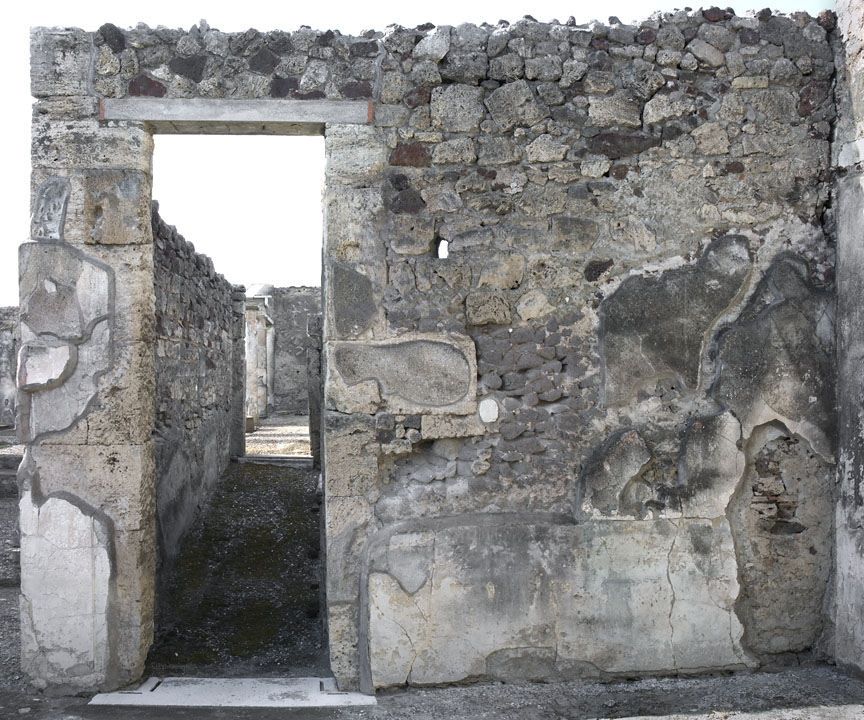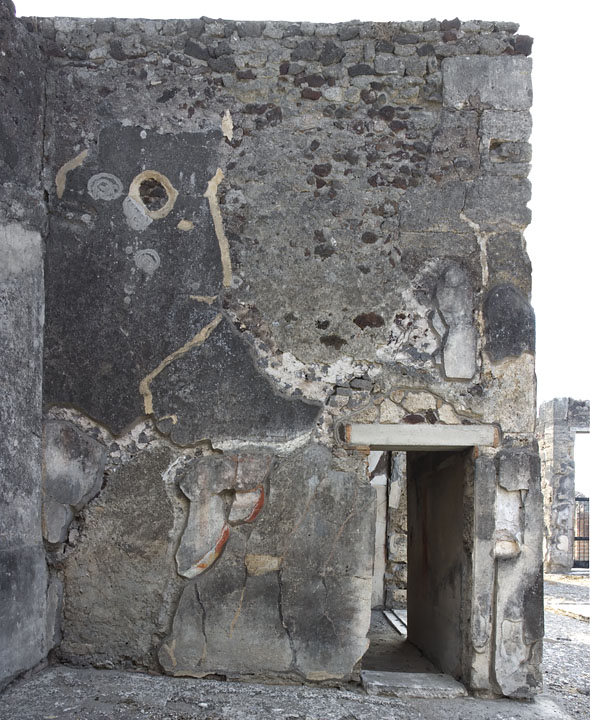Wall decoration (extant)
Description
Thomas Staub
The decorations of this room, which are mostly fainted away, has been ascribed to the Second Style (Mau 1882, 252f), more precisely to its phase I c (Beyen 1960, 74 - 81).Only faint remains of colour and lines are visible on the walls. A Danish architect, H.J. Holm has copied the east wall (Staub Gierow 2008, 29, fig. 1), which together with the description by Mau gives us some idea about its original layout.
North wall
In 1.13 m height, a joint is separating the lower and the upper parts of the plaster, probably the separation between the socle zone and middle zones. In the socle zone, isolated remains of colour seem to confirm the Danish water colour. In 1.60 m height, i.e. in the middle zone, 1.40 m from the north east corner, some remains of light and darker green, partly in the form of leaves on a red ground, must be remains of a garland adorning the area between the painted columns. The plaster of the middle and upper zones on this wall is abutting against the plaster of the east wall; only the plaster of the socle zone goes through over the walls.
Even though the east wall is nearly completely covered by plaster, only sporadic information about the decorations is obtainable. At 0.95 m height, a joint is visible in the plaster, and between 3.45 and 3.55 m there is a gap in the plaster. At 3.75 m height, a row of small holes can be observed, probably for the attaching of a stuccoed cornice. The corresponding area of the north wall is a modern reconstruction, whereas the row seems to continue on the south wall, at least for 1.50 m, thereafter the plaster is missing.
The faint remains of lines and colours on the wall confirm watercolour depicting this wall. Thus two lines are traceable, at 0.25 and 0.70 m height, corresponding with the separation between the green plinth and the black field in the socle of the copy and, between 0.45 and 0.70 m height, 0.15 m from the north east corner and 0.25 m from the south east corner, remains of red colours are preserved. Else, only remains of dark colour are visible. Between 0.95 and 1.05 m h, traces of yellow paintings are preserved, probably corresponding with the surface on which the columns are standing in the watercolour; else mainly red fragments are visible in the middle zone. At the north east corner, a 0.15 m wide vertical stripe shows remains of lighter colour, the same can be observed 1.20 m from that corner and at 1.15 m from the south east corner. At the top of that last stripe, the lighter coloured area widens a bit, probably remains of a painted capital. Above this, horizontal yellow and reddish stripes can be discerned, whose h and horizontal dimension are not measurable.
South wall
On the S wall, the fine plaster is preserved only up to max. 1.70 m height, above that only under plaster is visible. The plaster shows numerous damages and breaks, especially near the tunnelers break through, but no joint is recognizable between socle and middle zones. In 0.35 and 0.60 m height, horizontal scratch lines can be observed, the area in between seems to have been painted red, which is also visible at the eastern corner of the door towards cubiculum8. The plaster reaches into the door opening, indicating that the door cannot be later than the decorations on this wall. In addition, the plaster, covering the wall between this door and the opening towards atrium4, follows the doorframe. At 0.08 m from the western doorframe, a 0.02 m wide vertical line is visible, where the plaster is missing.
At the south east corner, a 0.15 m wide vertical stripe of unknown colour is traceable towards the west at 1.50 m height; some fragments of red are preserved. Other remains of colour can be observed in the central part of the wall, between 0.75 and 1.65 m height, especially where earlier, but still modern stripes of cement for fastening the different parts of plaster to the wall have been replaced by narrower ones. Here, in 0.95 m height, the wall is red, with a 0.05 m wide stripe of green colour, followed by further remains of red colour. Underneath this, a ca. 0.15 m high horizontal stripe is painted yellow, as it seems covered by the green vertical stripe, underneath this further fragments of green can be observed.
Even here, in the south east corner, the plaster of the middle and upper zones abuts against the plaster of the east wall; modern repairs obscure the situation in the socle zone.


